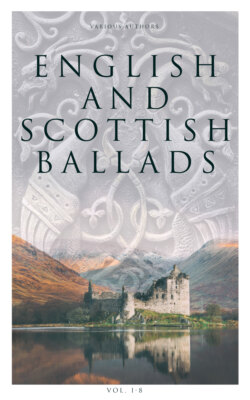Читать книгу English and Scottish Ballads (Vol. 1-8) - Various Authors - Страница 27
На сайте Литреса книга снята с продажи.
THOMAS OF ERSSELDOUNE.
ОглавлениеTable of Contents
This beautiful tale is transferred to these pages from Mr. Laing's Select Remains of the Ancient Popular Poetry of Scotland. The two "fytts" of prophecies which accompany it in the manuscripts, are omitted here, as being probably the work of another, and an inferior, hand. From the exordium by which the story is introduced, it might be concluded that the author was an Englishman. Indeed, all the poems and prophecies attributed to Thomas the Rhimer which remain to us, are preserved in English manuscripts and an English dress; but, in the judgment of Mr. Jamieson, the internal evidence still almost amounts to proof that the romance itself was of Scottish origin, although no indubitably Scottish copy is now known to be in existence.
The hero of this legend is believed to have lived through nearly the whole of the 13th century. He derived his territorial appellation from the village of Erceldoune, in the county of Berwick, lying on the river Leader, about two miles above its junction with the Tweed. The Huntly bank on which the meeting of Thomas with the Queen of Fairy took place, is situated, according to Mr. Laing, on one of the Eldoun hills, but the same distinction is claimed for another place of like name, which, together with an adjoining ravine, called from time immemorial the Rymer's Glen, was included in the domain of Abbotsford. (See Minstrelsy of the Scottish Border, iv. 110. v. 1.)
"During the 14th, 15th, and 16th centuries, to get up a prophecy in the name of Thomas the Rhymer appears to have been found a good stroke of policy on many occasions. Thus was his authority employed to countenance the views of Edward III. against Scottish independence, to favor the ambitious views of the Duke of Albany in the minority of James V., and to sustain the spirits of the nation under the harassing invasions of Henry VIII. A small volume containing a collection of the rhymes thus put into circulation was published by Andro Hart in Edinburgh, in 1615."—CHAMBERS, Pop. Rhymes of Scotland, p. 6.
"This poem," says Mr. Laing, "is preserved in three ancient manuscripts, each of them in a state more or less mutilated, and varying in no inconsiderable degree from the others. A portion of it was first printed in the Border Minstrelsy, [iv. 122,] from the fragment in the British Museum, among the Cotton MSS.; and the one which Mr. Jamieson adopted in his collection of Popular Ballads and Songs [ii. 11,] was carefully deciphered from a volume of no ordinary curiosity, in the University Library, Cambridge, written in a very illegible hand, about the middle of the 15th century. It is now printed from the other copy, as it occurs in a volume, compiled at a still earlier period, which is preserved in the Cathedral Library of Lincoln. On comparison, it will be readily perceived, that the text is in every respect preferable to that of either of the other manuscripts. … An endeavor has been made to fill up the defective parts from the Cambridge copy, though in some instances, as will be seen, without success."—Mr. Halliwell has republished the Cambridge text in his Fairy Mythology, (p. 58,) and he cites a fourth manuscript, which, however, appears to be of slight importance.
THOMAS OF ERSSELDOUNE.
22, Laing, by tene.[refers to line 22, missing
5, Linc. MS. throstylle cokke.
21, sette, Laing.
109, Lufly lady, i.e. Mary.
211, buse agayne.
2 What follows is abridged from Grundtvig, Danmarks Gamle Folkeviser, ii. 554.
